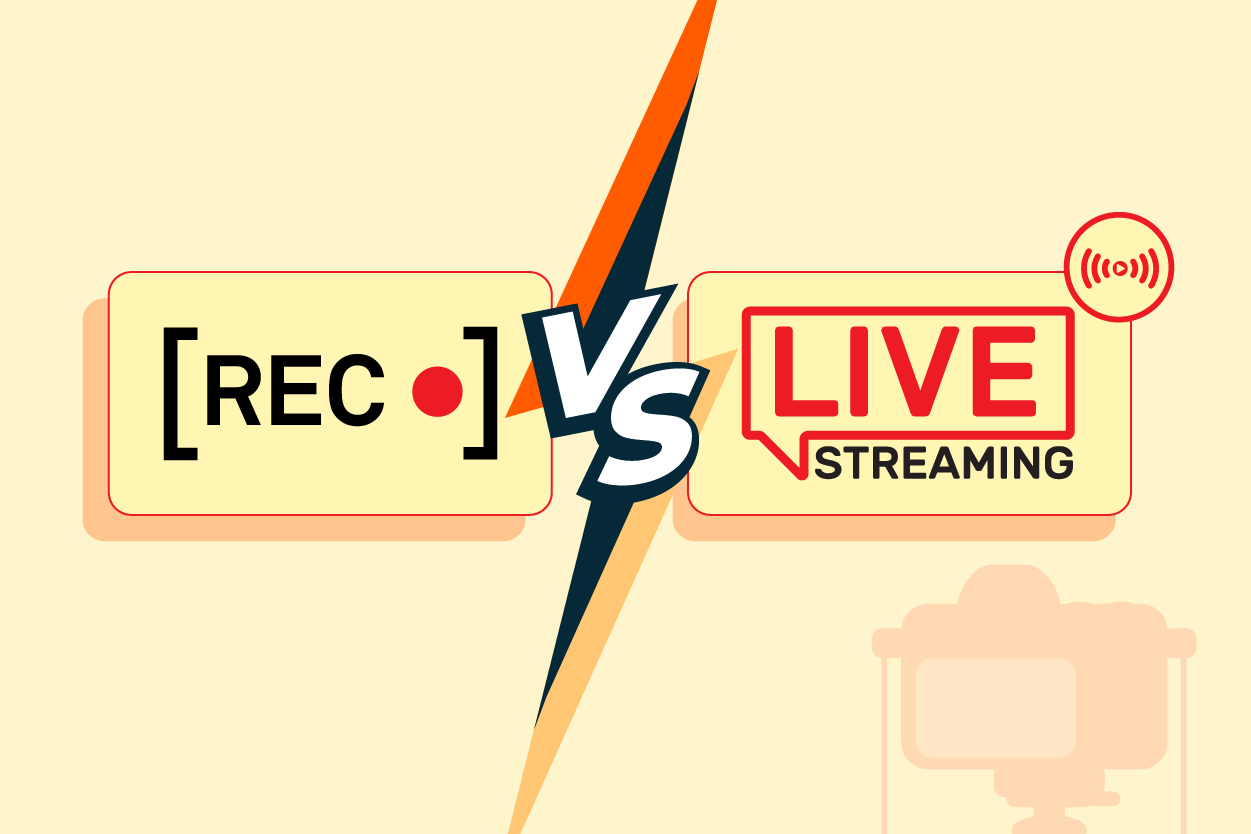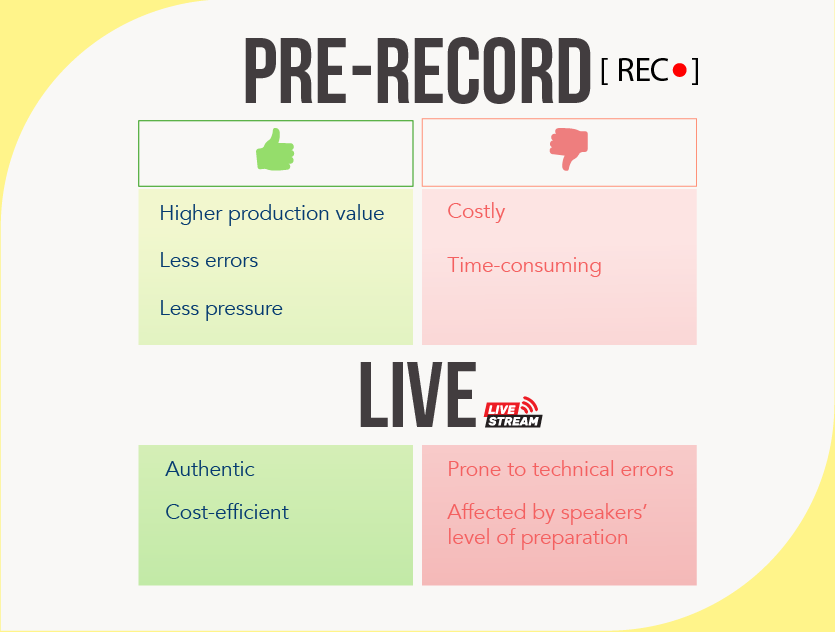

Is it better to pre-record or livestream your virtual event?

Both have their own merits, as well as downsides. Which road should you take?
The number of virtual events has risen significantly over the past year, given restrictions on live events and mass gatherings to curb the spread of the coronavirus.
Although it’s not new, virtual events have been undergoing major face-lifts to improve reach and engagement.
There are two ways to hold a virtual event — pre-record it or livestream. And as with everything else, each of these options has its own benefits and downsides.
Which one fits your virtual event better?

Pre-record
Pre-recording your event involves taping all the relevant footage you need beforehand, most prominently the various speaker presentations.
Since the pandemic started, this most often happens through remote recording, where the person handling the technical production is situated in a different location from the speaker.
Benefits
Higher production value
Definitely, pre-recording your footage will give you more control over the content as well as the ability to put more effort into the aesthetic aspects of your virtual event.
Since everything is prepared before the day of the actual event, there is much more room for you to design slides or animate transitions to enhance the audience experience.
Less errors
Of course, since everything is prerecorded, any errors can be edited out.
The organisers and moderators can rest easy — there is no fear that a speaker might say something wrong or controversial since such slip-ups can be cut out of the footage.
Less pressure
One of the perks of pre-recording an event is quite literally the fact that it is not live. This means there is less pressure on the speakers — they can feel more comfortable knowing they can retake any sequences or lines in case they fumble. Remember that not all of us have the charisma and public speaking skills of Ryan Seacrest!
It is also much less stressful for the technical operators of the virtual events since they are less likely to be required to do any live troubleshooting.
Drawbacks
Inauthentic
While pre-recording all your footage can help you achieve a polished final result, this might make your event come across as being too scripted and lacking the personal touch.
There also exists a gap in terms of engagement since there is no chance for real-time audience participation in terms of live Q&A sessions.
Costly and time-consuming
With a lot of work going in during the production stage, it is inevitable that pre-recording your virtual events would likely come with a higher price tag.
Features like adding seamless transitions between speakers, animating motion graphic elements on screen and including proper subtitling all come at additional costs.
Not to mention, a lot of time is also needed to schedule recordings with speakers and edit the footage so that only the best parts are kept and used in the final cut.
Live sessions
For this category, virtual events are streamed and broadcasted live to a real-time audience.
Benefits
Authentic
Your audience gets to watch livestreams in all their unedited and unfiltered glory — which takes the authenticity factor up a notch compared to pre-recordings.
Things unfold on screen as they are happening in real-time, which makes them much more dynamic. It’s the closest you’ll get to an in-person event.
By streaming your event live, you’ll also get better audience engagement. Your viewers can participate in polls or QnA sessions with your speakers and hosts.
Cost-efficient
Choosing to go live also helps to save money and time. Live events hardly have much room for fancy visual effects, animations, and transitions due to time constraints, which means less editing work is needed.
Drawbacks
Prone to technical errors
Since everything happens in real-time, the likelihood of something going wrong and becoming a problem is higher than a pre-recorded event. There might be little work to be done in the production stage, but the burden of the workload on the actual day of your event makes up for it.
As everyone knows, technical glitches do happen — even to those who are well-prepared. And sometimes the quality of the livestream is at the mercy of your speakers’ internet connection speeds, which is something that falls out of the control of the technical operators.
Affected by speaker level of preparation
Live streaming events are a one-take, one-time affair — there’s no repeat, no do-overs. If a speaker stumbles, it may become a memorable moment, but not necessarily for a good reason — there is a chance it might leave a bad impression on the speaker and your brand as well.
Therefore, it’s essential that your speakers rehearse and practice before the big day to avoid such incidents from occurring.
Virtual events are here to stay
At Click2View, we have helped companies like Grab transition to hosting virtual events smoothly, facilitating the production processes as well as the actual livestreams.
Apart from creating custom creative assets and animated transitions, we have also coached speakers on how to record themselves and provided them with practice sessions before the live event to ensure that the programme runs smoothly.
Be it live or pre-recorded, virtual events are here to stay — perhaps even long after the pandemic has passed. It’s one of the ways to keep your audience engaged and be aware of your brand no matter where they are.
Want to take your events into the virtual world seamlessly? Don’t hesitate to drop our producer Alex Chua a message at [email protected].
Read more from Click2View:
- Why you need a content calendar
- How to make sure your content stays accessible to all.
- This is why it’s important to repurpose content.
Sign up to our newsletter for a weekly update on the latest content marketing news. Don’t forget to subscribe to our YouTube channel too!
Click2View is Southeast Asia’s premiere full-service independent B2B content marketing agency servicing clients like Microsoft, Google, Visa, Prudential, and the Lee Kuan Yew School of Public Policy.








